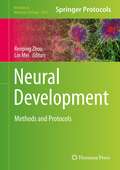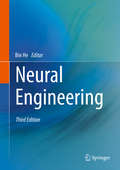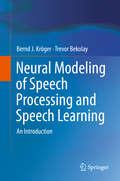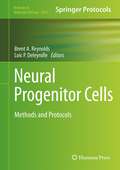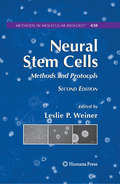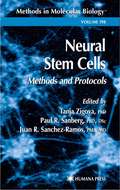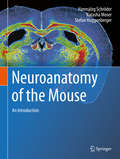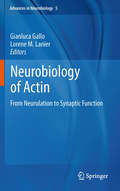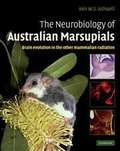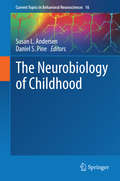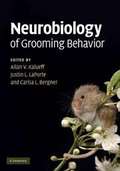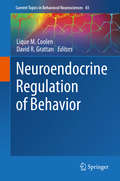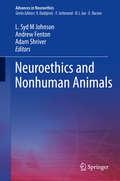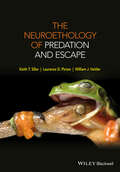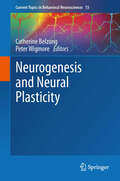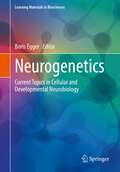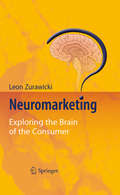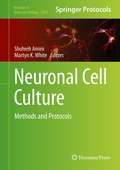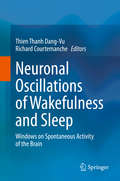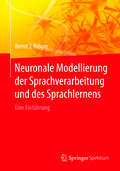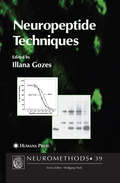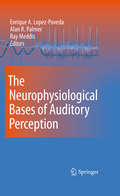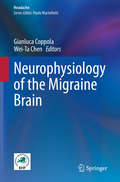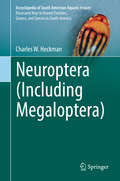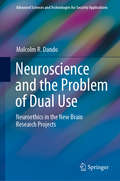- Table View
- List View
Neural Development
by Lin Mei Renping ZhouUnderstanding the molecular and cellular mechanisms underlying the development of specific neural circuits is not just an intellectual curiosity but also central to our ability to develop therapeutic approaches to repair damaged pathways in the future. In Neural Development: Methods and Protocols, experts in the field contribute commonly used protocols to facilitate future research in developmental neuroscience. Split into four convenient sections, this detailed volume covers techniques of culturing neurons and glia as well as their growth and differentiation, methods of gene delivery and down regulation, protocols for analyzing axon growth and guidance plus synapse formation, and, finally, basic methods to analyze brain morphology and axon pathways in developing animals. Written in the highly successful Methods in Molecular Biology series format, chapters include introductions to their respective topics, lists of the necessary materials and reagents, step-by-step, readily reproducible laboratory protocols, and tips on troubleshooting and avoiding known pitfalls. Comprehensive and accessible, Neural Development: Methods and Protocols provides key guidance for students and postdoctoral fellows new to developmental neurobiology.
Neural Engineering (Bioelectric Engineering Ser.)
by Bin HeThis third edition overviews the essential contemporary topics of neuroengineering, from basic principles to the state-of-the-art, and is written by leading scholars in the field. The book covers neural bioelectrical measurements and sensors, EEG signal processing, brain-computer interfaces, implantable and transcranial neuromodulation, peripheral neural interfacing, neuroimaging, neural modelling, neural circuits and system identification, retinal bioengineering and prosthetics, and neural tissue engineering. Each chapter is followed by homework questions intended for classroom use. This is an ideal textbook for students at the graduate and advanced undergraduate level as well as academics, biomedical engineers, neuroscientists, neurophysiologists, and industry professionals seeking to learn the latest developments in this emerging field.Advance Praise for Neural Engineering, 3rd Edition: “A comprehensive and timely contribution to the ever growing field of neural engineering. Bin He’s edited volume provides chapters that cover both the fundamentals and state-of-the-art developments by the world’s leading neural engineers." Dr. Paul Sajda, Department of Biomedical Engineering, Electrical Engineering and Radiology, Columbia University“Neural Engineering, edited by Prof. He, is an outstanding book for students entering into this fast evolving field as well as experienced researchers. Its didactic and comprehensive style, with each chapter authored by leading scientific authorities, provides the ultimate reference for the field.”Dr. Dario Farina, Department of Bioengineering, Imperial College London, London, UK "Neural Engineering has come of age. Major advances have made possible prosthesis for the blind,mind control for quadraplegics and direct intervention to control seizures in epilepsy patients. Neural Engineering brings together reviews by leading researchers in this flourishing field. Dr. Terrence Sejnowski, Salk Institute for Biolgical Studies and UC San Diego
Neural Modeling of Speech Processing and Speech Learning: An Introduction
by Bernd J. Kröger Trevor BekolayThis book explores the processes of spoken language production and perception from a neurobiological perspective. After presenting the basics of speech processing and speech acquisition, a neurobiologically-inspired and computer-implemented neural model is described, which simulates the neural processes of speech processing and speech acquisition. This book is an introduction to the field and aimed at students and scientists in neuroscience, computer science, medicine, psychology and linguistics.
Neural Progenitor Cells: Methods and Protocols
by Loic P. Deleyrolle Brent A. ReynoldsThe discovery of stem and progenitor cells in the adult mammalian CNS challenged the long standing "no new neuron" doctrine and opened the door to the potential for cell replacement therapy. The process from discovery to clinical applications can be long and tortuous, requiring rigorous steps involving standardized and precise protocols. Neural Progenitor Cells: Methods and Protocols is a collection of practical articles describing techniques used to study neural stem and progenitor cells. The volume also highlights the promise of stem cell-based therapeutic applications for CNS disorders. Written in the successful Methods in Molecular Biology series format, chapters include introductions to their respective topics, lists of the necessary materials and reagents, step-by-step, readily reproducible protocols, and notes on troubleshooting and avoiding known pitfalls. Authoritative and easily accessible, Neural Progenitor Cells: Methods and Protocols serves both professionals and novices with its well-honed methodologies.
Neural Stem Cells
by Leslie P. WeinerMany questions related to stem cell properties and neural stem cell lineage and differentiation still linger. This second edition revises and expands upon the successful first edition in order to provide the most current, cutting-edge methods of today for the scientists working to answer these questions. The use of these step-by-step, readily reproducible laboratory protocols will allow investigators to produce pure populations that can serve as a means of understanding the biology of neural stem cells and adapting them for transplantation into disease models. This is an excellent source of information and inspiration.
Neural Stem Cells
by Tanja Zigova Juan R. Sanchez-Ramos Paul R. SanbergIn Neural Stem Cells: Methods and Protocols, internationally recognized experts from academic, clinical, and pharmaceutical laboratories describe in great detail the most frequently used cellular, molecular, and electrophysiological methods to isolate, characterize, and utilize neural stem cells. These readily reproducible techniques introduce the various sources of stem/progenitor cells, provide a wide range of conditions for their culture, and make it possible to define their properties in culture. Additional techniques are designed to help researchers identify endogenous stem cells as well as exogenous stem cells after transplantation in the brain. The protocols range from the simplest methods of isolation and characterization of neural cell properties to such very sophisticated methods as characterizing gene expression, telomerase assays, and cell cycle kinetics.
Neuroanatomy of the Mouse: An Introduction
by Stefan Huggenberger Natasha Moser Hannsjörg SchröderThis textbook describes the basic neuroanatomy of the laboratory mouse. The reader will be guided through the anatomy of the mouse nervous system with the help of abundant microphotographs and schemata. Learning objectives and summaries of key facts at the beginning of each chapter provide the reader with an overview on the most important information.As transgenic mice are one of the most widely used paradigms when it comes to modeling human diseases, a basic understanding of the neuroanatomy of the mouse is of considerable value for all students and researchers in the neurosciences and pharmacy, but also in human and veterinary medicine. Accordingly, the authors have included, whenever possible, comparisons of the murine and the human nervous system. The book is intended as a guide for all those who are about to embark on the structural, histochemical and functional phenotyping of the mouse’s central nervous system. It can serve as a practical handbook for students and early researchers, and as a reference book for neuroscience lectures and laboratories.
Neurobiology of Actin
by Gianluca Gallo Lorene M LanierThis text is an introduction to the interface between the actin cytoskeleton and the myriad of issues fundamental to the understanding of the nervous system. It covers the neurobiology of actin ranging from basic cellular organization and function to the roles of actin in the health and disease states of the nervous system. Its opening chapter presents the fundamental concepts required to appreciate the details of the molecular machinery that regulates actin in a cellular context, setting the stage for the first part of the book which reviews the neurobiology of actin at the cellular level. The latter section of the book then discusses the functions of actin in the context of neurobiological issues ranging from early development to synaptic function and disease states of the nervous system. This text is intended for neuroscientists interested in investigating the actin cytoskeleton in the context of their particular neuroscience research program, and its chapters are cross-referenced in order to assist readers in finding relevant information that is covered in greater depth in other chapters.
The Neurobiology of Australian Marsupials
by Ken W. S. AshwellAustralian marsupials represent a parallel adaptive radiation to that seen among placental mammals. This great natural experiment has produced a striking array of mammals with structural and behavioural features echoing those seen among primates, rodents, carnivores, edentates and ungulates elsewhere in the world. Many of these adaptations involve profound evolutionary changes in the nervous system, and occurred in isolation from those unfolding among placental mammals. Ashwell provides the first comprehensive review of the scientific literature on the structure and function of the nervous system of Australian marsupials. The book also includes the first comprehensive delineated atlases of brain structure in a representative diprotodont marsupial (the tammar wallaby) and a representative polyprotodont marsupial (the stripe-faced dunnart). For those interested in brain development, the book also provides the first comprehensive delineated atlas of brain development in a diprotodont marsupial (the tammar wallaby) during the critical first 4 weeks of pouch life.
The Neurobiology of Childhood (Current Topics in Behavioral Neurosciences #16)
by Susan L. Andersen and Daniel S. PineDuring the past years there has been rapid progress in the understanding of how early life stress impacts psychopathology in children. The first two parts of this book present the basic principles of brain development and describe the most important neuronal systems. This includes systems involved in emotion processing, cognitive control, and social processes. These first two general sections are followed by an overview about recent research on various neuronal and psychiatric disorders, where environmental exposures and altered brain development play an important role: sleep, autism, ADHD and other developmental forms of psychopathology.
Neurobiology of Grooming Behavior
by Allan V. Kalueff Justin L. Laporte Carisa L. BergnerGrooming is among the most evolutionary ancient and highly represented behaviours in many animal species. It represents a significant proportion of an animal's total activity and between 30-50% of their waking hours. Recent research has demonstrated that grooming is regulated by specific brain circuits and is sensitive to stress, as well as to pharmacologic compounds and genetic manipulation, making it ideal for modelling affective disorders that arise as a function of stressful environments, such as stress and post-traumatic stress disorder. Over a series of 12 chapters that introduce and explicate the field of grooming research and its significance for the human and animal brain, this book covers the breadth of grooming animal models while simultaneously providing sufficient depth in introducing the concepts and translational approaches to grooming research. Written primarily for graduates and researchers within the neuroscientific community.
Neuroendocrine Regulation of Behavior (Current Topics in Behavioral Neurosciences #43)
by Lique M. Coolen David R. GrattanThis special volume provides twelve contributions that discuss different aspects of social and endocrine behaviors with an emphasis on the neural regulation of these behaviors. In addition, several review chapters address the neural plasticity that results from exposure to hormones or the experiences with the behavior. Finally, each of the contributions emphasizes future directions and incorporation of newly developed neuroscience techniques and approaches.
Neuroethics and Nonhuman Animals (Advances in Neuroethics)
by Andrew Fenton L. Syd M Johnson Adam ShriverThis edited volume represents a unique addition to the available literature on animal ethics, animal studies, and neuroethics. Its goal is to expand discussions on animal ethics and neuroethics by weaving together different threads: philosophy of mind and animal minds, neuroscientific study of animal minds, and animal ethics. Neuroethical questions concerning animals’ moral status, animal minds and consciousness, animal pain, and the adequacy of animal models for neuropsychiatric disease have long been topics of debate in philosophy and ethics, and more recently also in neuroscientific research. The book presents a transdisciplinary blend of voices, underscoring different perspectives on the broad questions of how neuroscience can contribute to our understanding of nonhuman minds, and on debates over the moral status of nonhuman animals. All chapters were written by outstanding scholars in philosophy, neuroscience, animal behavior, biology, neuroethics, and bioethics, and cover a range of issues and species/taxa. Given its scope, the book will appeal to scientists and students interested in the debate on animal ethics, while also offering an important resource for future researchers. Chapter 13 is available open access under a CC BY 4.0 license at link.springer.com.
The Neuroethology of Predation and Escape
by Keith T. Sillar William J. Heitler Laurence D. PictonThe forces of natural selection have been a primary driver in the evolution of adaptive animal behaviours. On the one hand animals must evade predation in order to survive and pass on their genes; on other hand, and for the same underlying reasons, animals must also be capable of successfully capturing prey. This situation has led to an evolutionary arms race in which predator and prey are locked in the battle to survive. A common strategy in each situation is to enhance the speed of response, resulting in the evolution of neural, muscular and biomechanical designs that produce supremely fast and eye-catching behavioral responses. The aim of this book is to illuminate the design principles of escape and predatory behaviours using a series of case histories from different animal groups and to emphasize the convergent evolution of neural circuitry that optimizes the chances of survival. Using these case histories the authors describe sensory mechanisms that aid prey and predator detection, central neural circuit designs that increase speed of response and neuromuscular and biomechanical properties that aid the performance of escape and predatory movements.
Neurogenesis and Neural Plasticity
by Catherine Belzung Peter WigmoreThis volume brings together authors working on a wide range of topics to provide an up to date account of the underlying mechanisms and functions of neurogenesis and synaptogenesis in the adult brain. With an increasing understanding of the role of neurogenesis and synaptogenesis it is possible to envisage improvements or novel treatments for a number of diseases and the possibility of harnessing these phenomena to reduce the impact of ageing and to provide mechanisms to repair the brain.
Neurogenetics: Current Topics in Cellular and Developmental Neurobiology (Learning Materials in Biosciences)
by Boris EggerThis textbook provides students with knowledge of neurogenetics, neurogenesis, neuronal specification and function, neuronal networks, learning and memory formation, brain evolution, and neurodegenerative diseases.Students are introduced to topics of classical developmental genetics as well as modern molecular and neurogenetic methods. Using a wealth of examples from current research, the textbook takes a strong applied approach. Using animal models such as Drosophila melanogaster and Caenorhabditis elegans as well as mammalian systems, the interrelationships between genes, neurons, nervous systems, and behaviour under normal and pathological conditions are illustrated. The textbook aims encourage students to address biological questions in neurogenetics and to think about the design of their own experiments. It targets primarily master and graduate students in neurobiology, but is also a valuable teaching tool for instructors in these fields.
Neuromarketing
by Leon ZurawickiOver the last 10 years advances in the new field of neuromarketing have yielded a host of findings which defy common stereotypes about consumer behavior. Reason and emotions do not necessarily appear as opposing forces. Rather, they complement one another. Hence, it reveals that consumers utilize mental accounting processes different from those assumed in marketers' logical inferences when it comes to time, problems with rating and choosing, and in post-purchase evaluation. People are often guided by illusions not only when they perceive the outside world but also when planning their actions - and consumer behavior is no exception. Strengthening the control over their own desires and the ability to navigate the maze of data are crucial skills consumers can gain to benefit themselves, marketers and the public. Understanding the mind of the consumer is the hardest task faced by business researchers. This book presents the first analytical perspective on the brain - and biometric studies which open a new frontier in market research.
Neuronal Cell Culture: Methods and Protocols
by Martyn K. White Shohreh AminiIn Neuronal Cell Culture: Methods and Protocols, the latest aspects of the culture of neural cells are explored by experts in the field who also explain the practical and theoretical considerations of the techniques involved. Starting with a general overview of the neuronal culturing principles that are described, this detailed volume covers cell line models for neural cells, the isolation and propagation of primary cultures, stem cells, transfection and transduction of neural cultures, and other more advanced techniques. Written for the Methods in Molecular Biology series, chapters include introductions to their respective topics, lists of the necessary materials and reagents, step-by-step, readily reproducible laboratory protocols, and tips on troubleshooting and avoiding known pitfalls. Practical and easy to use, Neuronal Cell Culture: Methods and Protocols will be of interest to scientists at all levels developing cell culture models for neuroscientific studies.
Neuronal Oscillations of Wakefulness and Sleep: Windows on Spontaneous Activity of the Brain
by Thien Thanh Dang-Vu Richard CourtemancheThe purpose of this work is to review recent findings highlighting the mechanisms and functions of the neuronal oscillations that structure brain activity across the sleep-wake cycle. An increasing number of studies conducted in humans and animals, and using a variety of techniques ranging from intracellular recording to functional neuroimaging, has provided important insight into the mechanisms and functional properties of these brain rhythms. Studies of these rhythms are fundamental not only for basic neuroscience, but also for clinical neuroscience. At the basic science level, neuronal oscillations shape the interactions between different areas of the brain and profoundly impact neural responses to the environment, thereby mediating the processing of information in the brain. At the clinical level, brain oscillations are affected in numerous neurological conditions and might provide useful biomarkers that inform about patients’ evolution and vulnerability. During sleep, these brain rhythms could provide functional support to internal states that govern the basic maintenance of local circuit and systemic interactions. During wake, the rhythmicity of cortical and subcortical circuits have been linked with sensory processing, cognitive operations, and preparation for action. This book will attempt to link together these sleep and wake functional roles at the level of neuroimaging and electroencephalographic measures, local field potentials, and even at the cellular level.
Neuronale Modellierung der Sprachverarbeitung und des Sprachlernens: Eine Einführung
by Bernd J. KrögerDieses Buch erläutert die Thematik der Produktion und Wahrnehmung gesprochener Sprache aus neurowissenschaftlicher Sicht. Nach der Darstellung der Grundlagen der Sprachverarbeitung und des Spracherwerbs wird dem Leser ein neurobiologisch basiertes und computerimplementiertes neuronales Simulationsmodell vorgestellt. Diese Einführung in die quantitative und computerimplementierbare Modellierung der Sprachverarbeitung und des Sprachlernens basiert auf einem naturwissenschaftlich orientierten Ansatz zur Beschreibung gesprochener Sprache. Dennoch wird weitgehend auf mathematische Beschreibungen verzichtet.Das Buch spricht Studierende und Wissenschaftler der Bereiche Neurowissenschaften, Informatik, Medizin, Psychologie und Linguistik an, die sich in das Gebiet der Sprachverarbeitung und des Spracherwerbs aus neurowissenschaftlicher Sicht einarbeiten möchten. Es richtet sich aber auch an Anwender, die sich mit der Entwicklung von Software zur Sprachverarbeitung befassen.
Neuropeptide Techniques
by Illana GozesNeuropeptides exhibit multiple functions as hormones and regulators. As such, many techniques are required to understand the contribution and functions of neuropeptides in health and disease processes. Research in the neuropeptide field is aimed toward a better understanding of the physiology of the human body and toward the development of better diagnostics and therapeutics. This book will familiarize the audience with forefront techniques in the field.
The Neurophysiological Bases of Auditory Perception
by Ray Meddis Enrique Lopez-Poveda Alan R. PalmerThe International Symposium on Hearing is a triennial, highly-prestigious event where world-class scientists present and discuss the most recent advances in the field of hearing research. The symposium focuses on the relationship between auditory physiology, psychoacoustics, and computational modeling. Presented papers range from basic to applied research, and are published in book format. The books from past editions have a large demand by neuroscientists, otolaryngologists, psychologists, and artificial intelligence researchers. This meeting is highly special in that every paper is a plenary session given by invitation by a key, world-class auditory scientist. There are no poster sessions. The editors will have to choose the best 60 papers from approximately 80 submitted abstracts. Priority will be given to hot topics and to papers showing significant advances (this is almost guaranteed, anyhow, by the quality of the speakers). Papers will be submitted by invitation only and invitations will be sent only to the most-significant auditory scientists at present. Furthermore, published papers can be regarded as peer-reviewed because they will be accompanied (in print) by a full discussion between the authors and other conference attendants. This format is identical to that of preceding editions of this symposium and has proven highly successful. A full list of past conference books is given below. We will not know the list of chapters until approximately November 2008, that is 6 months before the conference (May 2009). You can get an idea of the type and format of the chapters by having a look at the books for the last two symposium editions, which were published by Springer.
Neurophysiology of the Migraine Brain (Headache)
by Gianluca Coppola Wei-Ta ChenRoughly one in every five patients referred to a neurologist suffers from headaches; the majority have migraines. Although headache specialists understand migraine on a clinical basis, the pathophysiological changes that provoke and accompany the development of a migraine attack continue to elude us. Several decades have passed since the pioneering electroencephalographic study by Golla and Winter (1959), which underscored the role of abnormal rhythmic activities in migraine. Since then, there have been substantial advances in the field; a wealth of neurophysiological studies has enriched our understanding of the pathophysiological facets of the migraine pathology. Virtually every known technique of clinical electrophysiology has since been used to study the migraine brain and, more recently, new neurophysiological tools have been added to the arsenal. Nevertheless, applying the principles of peripheral and central neuromodulation offers a promising way to transfer the principles of synaptic plasticity to the patient’s bedside. This book belongs to the Headache Series endorsed by the European Headache Federation. Written by internationally recognized experts in their respective fields, it covers all aspects of clinical neurophysiological methods that represent significant advances in our understanding of the pathophysiology of migraine. It will offer a valuable toolkit for beginners, and a reference guide for experts.
Neuroptera (Including Megaloptera)
by Charles W. HeckmanThis order once encompassed all insects with a complex network of wing veins, regardless of whether their metamorphosis was incomplete or complete. By the early 20th century, most of the species had been transferred to new orders, leaving only a small percentage of the insects once assigned to the Neuroptera remaining in that order. By the second half of the 20th century, some of the taxonomists began to believe that the fragmentation of this order had gone too far, and that the order Megaloptera needed to be grouped in some way with Neuroptera, either by making them suborders of the same order or by creating a superorder to accommodate both. This volume provides a discussion of both taxa, tentatively regrouping both in the order Neuroptera. While all known species of Megaloptera in South America have completely aquatic larval stages, few species in the suborder Planipennia, formerly called Neuroptera sensu stricto, are aquatic during any of their life stages. The most interesting of the exceptions are species in the family Sisyridae, some of which develop as larvae inside freshwater sponges. Because only a relatively small number of species are still included in Neuroptera sensu lato, this book provides keys to all known South American species that have been described well enough to be identified with any degree of certainty. Many species in the family Chloropidae, the neuropteran family with the greatest number of recognized species in South America, have proven to be valuable as biological controls for insect pests in agriculture. Their importance for tropical agriculture is another reason for including terrestrial species in this book. The series will continue with volumes providing keys to identify species of other South American orders, but in most cases, only aquatic insects can be included in the keys to the species.
Neuroscience and the Problem of Dual Use: Neuroethics in the New Brain Research Projects (Advanced Sciences and Technologies for Security Applications)
by Malcolm R. DandoThis book discusses recent brain research and the potentially dangerous dual-use applications of the findings of these research projects. The book is divided into three sections: Part I examines the rise in dual-use concerns within various state’s chemical and biological non-proliferation regime’s during this century, as well as the rapid technologically driven advances in neuroscience and the associated possible misuse considerations in the same period. Part II reviews the brain research projects in the EU, USA, Japan, China and several other countries with regard to their objectives, achievements and measures to deal with the problem of dual-use. Part III assesses the extent to which the results of this civil neuroscience work, which is intended to be benign, are being, and could be protected against future hostile applications in the development of novel chemical and biological weapons.
